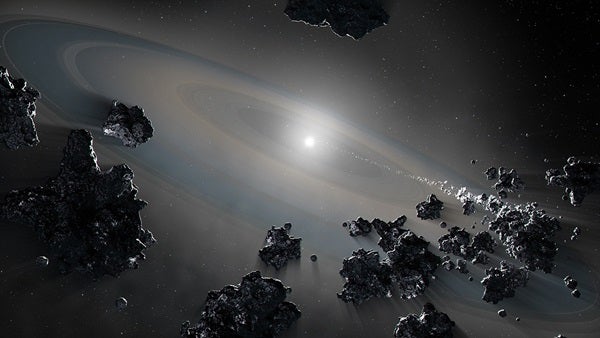Ten billion years ago, a star in the Milky Way known as WD J2147-4035 collapsed into a smoldering core. This stellar ember was surrounded by a thin atmosphere made of the remnant hydrogen and helium it once burned. Without fuel for fusion, however, the white dwarf slowly cooled, feebly glowing against the backdrop of space.
But still, the white dwarf was not done shaping its stellar neighborhood.
Thanks to clues embedded in the atmosphere of WD J2147-4035, researchers recently discovered the white dwarf once hosted rocky planetesimals. The new research, published Nov. 5 in Monthly Notices of the Royal Astronomical Society, shows that WD J2147’s atmosphere has since been “polluted” by metals — elements heavier than the hydrogen and helium typical of white dwarfs.
These metals would have come from rocky bodies that once orbited the star but were subsequently torn apart by its immense gravity and violent evolution, Abbigail Elms, an astrophysicist at the University of Warwick and lead author of the study, tells Astronomy. “This rocky debris would have eventually spiraled inward and accreted onto the star’s atmosphere,” she adds.
The researchers show that WD J2147 became a white dwarf some 10.2 billion years ago — after existing as a main-sequence star for just 500 million years. This makes WD J2147 the oldest metal-polluted star discovered to date, as well as the oldest known star likely to have hosted a planetary system.
What old white dwarfs can teach us
Studying old stars like WD J2147 can help researchers learn a lot about the early evolution of galaxies. And metal-polluted white dwarfs are particularly interesting because they accreted their heavy material during a time when many galaxies were made of mostly hydrogen and helium.
“The early [Milky Way] was less metal-rich than it is today, as metals are created and distributed when evolved stars explode as supernovae,” says Elms. “Hence, lots of time needs to have gone by for stars to have been born, to have lived, and then died,” she adds.
Another mysterious feature of WD J2147 is that it seems to have accreted large amounts of potassium and lithium. “This is highly unusual,” Keith Putirka, a planetary scientist at California State University who was not involved with the study, tells Astronomy.
Putirka says the closest analog to the material found in the white dwarf’s atmosphere would be peridotite. But this rock type, which is common on Earth, doesn’t have the massive amounts of potassium and lithium seen in the white dwarf’s atmosphere.
Large amounts of potassium and lithium have been found in other metal-polluted white dwarfs, however. “Perhaps early galaxies formed planets with bulk compositions that were different from what we find amongst the inner planets in our solar system,” says Putirka.
A white dwarf with a hint of Earth
In the study, Elms and her team also analyzed the atmosphere of another white dwarf in the Milky Way, WD J1922+0233. They found that this white dwarf’s atmosphere contains metals from rocks that are similar in composition to those found in Earth’s crust.
Putirka says that, based on the silicon and magnesium content, it seems the star accreted rocky material similar in composition to a rock type called andesite, which is present in volcanic zones on Earth. This find suggests that rocky exoplanets with Earth-like crusts could be common — though it’s far from a smoking gun.
The majority of stars in the universe are destined to become white dwarfs, a fate our Sun will also succumb to in about 6 billion years. And current research suggests that more than a quarter of these stars might harbor rocky debris in their atmospheres.
“Researching metal-polluted white dwarfs is an exciting opportunity to discover ancient planetary systems and to determine if exoplanets with continental crust-like compositions were common before the Earth even formed,” says Elms.










